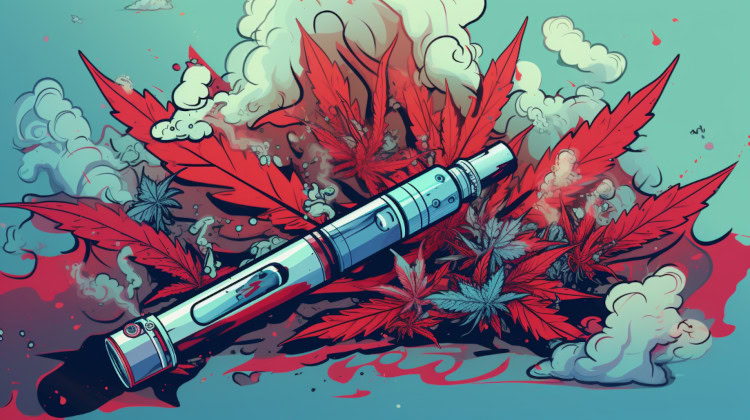In This Article
- How to Vape CBD
- 1. Choose Your Device
- 2. Pick Your Product
- 3. Load Your Vape
- 4. Inhale and Dose Carefully
- Maintenance Tips
- What Is CBD, Anyway?
- What Does a CBD Vape Actually Do?
- Reasons People Vape CBD
- Quick Onset of Effects
- High Bioavailability
- Potential Harm Reduction
- Stronger Effects with Less Product
- Discreet and Portable
- Not a Cure-All
- Risks of Vaping CBD
- Potential Health Risks
- Harmful Additives
- Lung Health
- CBD-Specific Concerns
- Regulated Products Are Safer
- Vaping vs. Other Consumption Methods
- Smoking vs. Vaping
- Edibles vs. Vaping
- Oils/Tinctures vs. Vaping
- Choosing the Right CBD Vape
- Lab Testing
- Product Information
- Reputable Brands
- Cartridge Compatibility
- Avoiding Fake Products
- Frequently Asked Questions (FAQ)
- Is CBD safe for vaping?
- Do CBD vapes get you buzzed?
- Will a CBD vape show on a drug test?
- References
Key Takeaways
- Pick a quality reusable device with a lab-tested cart from a known brand > Connect the cart to the battery > Press the heating button, and take 1-2 small puffs > Wait 10-15 min. to feel the effects.
- People choose to vape CBD for the quick effects, strong effects, possible harm reduction compared with smoking, and discreet nature of vapes.
- Choose quality vape products from well-established, reputable brands. Make sure your carts are legitimate and lab-tested.
Vaping CBD is one of the fastest ways to feel its effects. It works quickly and lets you control how much you use, making it a popular choice.
There are a lot of products out there, so it can be tough to know where to start. Looking at some of the best CBD vapes can help you understand what might work for you.
It's also good to know about vaping CBD, including how it works, its benefits and risks, and how to choose the right product.
How to Vape CBD
Vaping CBD is simple once you know what to look for. Below is a quick guide to help you get started.
1. Choose Your Device
First, decide between a disposable vape pen or a cartridge with a reusable battery.
- Disposable Pens: These are pre-filled and meant to be discarded after use. They’re convenient but less eco-friendly.
- Cartridges: These attach to a separate battery, like a 510-thread, which fits most carts. Some brands use their own proprietary cartridges, so make sure your battery is compatible.
- Dry Herb Vaporizers: If you prefer vaping flower instead of oil, look for a device designed for loose CBD flower, like the Pax Plus.
When buying a device, make sure it’s from a reputable brand. Fake or untested products can pose health risks, so stick with reliable options that offer lab results.
2. Pick Your Product
Consider what kind of effects you’re looking for. CBD vapes come in different ratios of CBD to THC.
- Hemp-Derived CBD: Contains 0.3% delta-9 THC or less, making it federally legal.
- High-CBD Vapes: Great to maximum CBD effects with minimal intoxication.
- Balanced Ratios: In legal states, you might find options like 1:1 or 3:1 CBD to THC. These can offer stronger effects while still keeping THC levels low.
3. Load Your Vape
Follow the instructions for your specific device. If using a cartridge, screw it onto the battery. For dry herb vapes, pack the chamber with ground flower.
4. Inhale and Dose Carefully
Activate the device, usually by pressing a button or simply inhaling. Take one or two small puffs and wait 5–10 minutes to see how you feel. CBD’s effects are usually noticeable within that time.
If you are new to vaping, start slow and give your body time to adjust. You can always take more if needed.
Maintenance Tips
To keep your vape working well:
- Clean the device regularly to prevent residue buildup.
- Store it in a cool, dry place.
- Keep your cartridges upright to prevent leaks.
What Is CBD, Anyway?

CBD, short for cannabidiol, is a natural compound found in cannabis. Unlike THC, it's not intoxicating. It's popular because it may still offer therapeutic benefits, like pain relief and stress management.
CBD interacts with the body’s endocannabinoid system (ECS), which helps regulate functions like mood, sleep, and pain. Its non-intoxicating nature and versatility make it a popular option for many consumers.
Since the 2018 Farm Bill made hemp-derived CBD legal across the U.S., a wide range of products have hit the market, from edibles and tinctures to vape pens and topicals. Vaping, in particular, has become a go-to method for fast-acting effects.
What Does a CBD Vape Actually Do?
Vaping CBD works by heating the oil or flower just enough to release cannabinoids without causing combustion. Unlike smoking, which burns the plant material, vaping instead produces a vapor. This makes it a cleaner option for those looking to avoid smoke exposure.
Research shows that vaping cannabis may reduce exposure to toxins, carbon monoxide, and respiratory irritants. It does so while still delivering similar effects to smoking.1
Vaping also allows for more efficient delivery of cannabinoids compared to oral consumption. Edibles can take much longer to kick in and produce less consistent effects.2
A wide range of vape products are available, from disposables and cartridges to refillable devices. However, not all products are created equal. Some unregulated vapes can contain harmful additives and contaminants. That’s why it’s important to know the dangers of fake carts and choose lab-tested options to reduce potential risks.
Reasons People Vape CBD

People choose to vape CBD for a variety of reasons. However, vaping stands out for its fast onset and high bioavailability compared to edibles and oils.3
Quick Onset of Effects
One of the main reasons people choose vaping over other methods is how quickly it works. Inhalation allows cannabinoids to enter the bloodstream rapidly, providing effects almost immediately. This makes it a great option for those looking to feel the effects as quickly as possible.¹
High Bioavailability
Vaping delivers cannabinoids more efficiently than oral ingestion. Studies show that inhaled cannabinoids can have up to 35% bioavailability, compared to as low as 6% for other oral forms. This means you get more out of your dose with less product.
Potential Harm Reduction
Compared to smoking, vaping reduces exposure to harmful toxins and carbon monoxide.² This makes it a potentially cleaner option for those who want to minimize respiratory risks while still enjoying the effects of CBD. Some also use CBD vapes as part of their journey to quit smoking.³ But it's important to know that vaping is not without risk.
Stronger Effects with Less Product
Vaping can deliver stronger effects with the same dose compared to oral consumption.² This means you might not need to use as much to achieve your desired results.
Discreet and Portable
CBD vapes are small and easy to carry, making them convenient for use on the go. They produce minimal odor compared to smoking, making them a more discreet option.
Not a Cure-All
While CBD offers potential therapeutic benefits, it’s important to remember that it’s not a cure-all. Its effectiveness can vary based on individual health conditions and possible interactions with other medications.4
Risks of Vaping CBD
While vaping CBD has benefits, it’s important to be aware of the potential risks, especially regarding product quality and safety.
Potential Health Risks
Not all CBD vape products are created equal. Unregulated or counterfeit vapes can contain harmful additives and contaminants, putting consumers at risk.5
Misleading labels and unsafe ingredients are still common. Stick with reputable brands that provide third-party lab testing.
Also, many CBD vapes contain intoxicating cannabinoids as well, which could cause a positive drug test and present safety risks while engaged in safety sensitive tasks, so be sure to check the label before use.
Harmful Additives
Some vaping products contain potentially harmful ingredients considered toxic and carcinogenic. These include carbonyls, volatile organics, nitrosamines, and heavy metals.6
These substances, and others, can lead to respiratory and other health problems, especially when inhaled regularly.
Lung Health
One of the most concerning risks associated with vaping is lung injury. Vaping-associated lung injury (EVALI) has been linked to unregulated vape cartridges and e-cigarettes. Some may contain synthetic cannabinoids or cutting agents that damage lung tissue.7
Additionally, research shows that vaping CBD aerosols may trigger a stronger inflammatory response and greater toxicity to human cells compared to nicotine.8
CBD-Specific Concerns
CBD itself is considered safe for most people. However, it may still cause side effects like drowsiness, dry mouth, or changes in appetite, especially in high doses. It may also interact with certain medications, so it’s important to consult a healthcare provider before use.
Regulated Products Are Safer
Choosing regulated and lab-tested products helps reduce risks. Reputable manufacturers follow quality control standards, including independent testing for contaminants and accurate labeling of cannabinoid content.⁵ This is essential for ensuring a safer vaping experience.
Vaping vs. Other Consumption Methods

There are many ways to consume CBD, each with its own pros and cons. Vaping is popular for its fast effects and potential harm reduction compared to smoking. But how does it compare to other common methods?
Smoking vs. Vaping
- Delivery: Smoking involves inhaling cannabis through combustion, which creates smoke. Vaping heats the CBD without burning it, producing vapor instead. This means you’re inhaling fewer harmful byproducts compared to smoking.
- Risk Factors: Smoking can expose you to toxins and carcinogens from combustion, which may affect your lung health. Vaping may reduce exposure to these harmful compounds, making it a cleaner option.
- Bioavailability: Vaping delivers cannabinoids more efficiently than smoking. Both methods allow rapid absorption through the lungs, but vaping may provide stronger effects with the same amount.
Edibles vs. Vaping
- Delivery: Edibles involve eating CBD-infused food or drinks, which are processed through the digestive system and metabolized in the liver. This can delay the effects for up to two hours. In contrast, vaping delivers CBD directly to the lungs for almost immediate effects.
- Risk Factors: Edibles carry a higher risk of overconsumption because of the delayed onset.³ It’s easy to take more before the first dose kicks in. Vaping avoids this problem by offering quick results, making it easier to gauge your dose.
- Bioavailability: Edibles typically have lower bioavailability due to being broken down in the digestive system. This means vaping may feel more potent even when using less product.
- CBD itself is non-psychoactive, regardless of how you consume it. If you're wondering if CBD gets you high, it doesn't unless the product contains other intoxicating cannabinoids like Delta 8—no matter the method. If you prefer eating your CBD instead, there are plenty of CBD edibles to choose from.
Oils/Tinctures vs. Vaping
- Delivery: Oils and tinctures are usually taken under the tongue, where they absorb through the mucous membranes. This method works faster than edibles but slower than vaping.
- Risk Factors: Oils and tinctures are considered safe and controlled methods of CBD consumption. They’re less likely to cause overconsumption compared to edibles.
- Bioavailability: Sublingual use provides bioavailability similar to edibles but is still lower than inhalation. Tinctures can be a good option if you want longer-lasting effects without vaping.
Choosing the Right CBD Vape
Finding a good CBD vape can be tricky with so many options out there. Here are a few tips to help you choose a safe, reliable product.
Lab Testing
Look for products that have been tested by an independent lab. This shows that the product has been checked for cannabinoid content and screened for things like pesticides, heavy metals, and other contaminants.
Product Information
Always check the label for important details, like how much CBD or THC it contains and the total weight. This helps you know what you’re getting and how strong it might be.
Reputable Brands
Stick with brands that have a good reputation and follow quality standards. These companies are more likely to make safe and effective products.
Cartridge Compatibility
Make sure the cartridge you pick works with your vape pen. Some brands use cartridges that only fit their devices, so double-check before buying.
Avoiding Fake Products
Counterfeit and unregulated vapes can be dangerous. They might contain harmful additives or have inaccurate labels. To be safe, choose products that come from reputable companies and have been tested for quality.
There are a lot of choices out there, but exploring some of the best CBD vapes can help you find one that works for you.
Frequently Asked Questions (FAQ)
Is CBD safe for vaping?
It's never safe to vape or smoke. Inhaling substances always carries a risk of harm to the lungs. Vaping CBD is generally considered safer when using regulated, lab-tested products. However, unregulated or counterfeit vapes can pose additional health risks, including exposure to harmful additives and contaminants.8
Some studies suggest that vaping CBD aerosols can trigger more inflammation in the lungs compared to vaping nicotine.7
Do CBD vapes get you buzzed?
No, CBD itself is non-intoxicating and won’t get you high.3 However, some CBD vapes may contain small amounts of THC or intoxicating amounts of THC variants, especially if they’re full-spectrum products. Make sure to check the label to know exactly what you’re consuming.
Will a CBD vape show on a drug test?
It’s possible, especially if the product contains trace amounts of THC or Delta 8, 10, HHC or other types of minor cannabinoids. Some CBD vapes labeled as “broad-spectrum” or “full-spectrum” may still have small amounts of THC that can be detected in a drug test.9 To reduce the risk, opt for CBD isolate vapes that contain no THC.
References
- Chaiton M, Kundu A, Rueda S, Di Ciano P. Are vaporizers a lower-risk alternative to smoking cannabis?. Can J Public Health. 2022;113(2):293-296. doi:10.17269/s41997-021-00565-w ↩︎
- Spindle TR, Bonn-Miller MO, Vandrey R. Changing landscape of cannabis: novel products, formulations, and methods of administration. Curr Opin Psychol. 2019;30:98-102. doi:10.1016/j.copsyc.2019.04.002 ↩︎
- Lucas CJ, Galettis P, Schneider J. The pharmacokinetics and the pharmacodynamics of cannabinoids. Br J Clin Pharmacol. 2018;84(11):2477-2482. doi:10.1111/bcp.13710 ↩︎
- Morales P, Reggio PH. CBD: A New Hope? ACS Med Chem Lett. 2019;10(5):694-695. doi:10.1021/acsmedchemlett.9b00127 ↩︎
- Hazekamp A. The Trouble with CBD Oil. Medical Cannabis and Cannabinoids. 2018;1(1):65-72. doi:10.1159/000489287 ↩︎
- MacCallum CA, Lo LA, Pistawka CA, Boivin M. A Clinical Framework for Evaluating Cannabis Product Quality and Safety. Cannabis and Cannabinoid Research. 2022;8(3):567-574. doi:10.1089/can.2021.0137 ↩︎
- Chadi N, Minato C, Stanwick R. Cannabis vaping: Understanding the health risks of a rapidly emerging trend. Paediatr Child Health. 2020;25(Suppl 1):S16-S20. doi:10.1093/pch/pxaa016 ↩︎
- Bhat TA, Kalathil SG, Goniewicz ML, Hutson A, Thanavala Y. Not all vaping is the same: differential pulmonary effects of vaping cannabidiol versus nicotine. Thorax. 2023;78(9):922-932. doi:10.1136/thorax-2022-218743 ↩︎
- Rapin L, Gamaoun R, El Hage C, Arboleda MF, Prosk E. Cannabidiol use and effectiveness: real-world evidence from a Canadian medical cannabis clinic. J Cannabis Res. 2021;3(1):19. Published 2021 Jun 23. doi:10.1186/s42238-021-00078-w ↩︎
The information in this article and any included images or charts are for educational purposes only. This information is neither a substitute for, nor does it replace, professional legal advice or medical advice, diagnosis, or treatment. If you have any concerns or questions about laws, regulations, or your health, you should always consult with an attorney, physician or other licensed professional.




